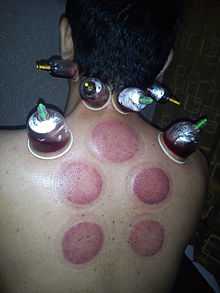Hijama

Hijama ( lit. "sucking") is the Arabic name in traditional medicine for wet cupping, where blood is drawn by vacuum from a small skin incision for therapeutic purposes.[1] It is reported that the Islamic prophet Muhammad said, "Indeed the best of remedies you have is hijama, and if there was something excellent to be used as a remedy then it is hijama."[2]
Procedure
Hijama can be performed almost anywhere on the body, often at the site of an ache or pain in order to ease or alleviate it. A more conservative approach[3] warns against over use of cupping and suggests only that six optimal points on the body are all that is required to "clean" the entire cardiovascular system.
The location is first shaved, if necessary, to ensure a tight seal with the cup. The mouth of a cup (metal, glass and plastic cups are generally used, although traditionally horns were used) is placed on the skin at the site chosen for hijama. Then a tight seal is created. The traditional method is to burn a small piece of paper or cotton inside the vessel, so that the mouth of the cup clings to the skin. Some practitioners now use a machine instead of the manual cups. Some practitioners still strictly adhere to the Prophetic method with the use of fire, both for sterility [citation needed] and the benefits or properties from the element of fire itself that may be present. The cup is left to cling to the skin for a few minutes, then it is lifted off and several very small incisions are made in the skin. The cup is then put back as it was before until the flow of blood subsides.[citation needed]
Hijama is considered a form of energy medicine because it has been claimed to unclog the meridians in the body, and is viewed by some practitioners as a cure that can alleviate black magic and possession.[4]
Scientific Studies
In March 2011 three systematic reviews were analyzed for the effectiveness of wet and dry cupping in which two out of three showed some evidence for effectiveness of cupping for pain. Favorable effects were shown when wet cupping was combined with adjuvant conventional treatments. However, one of the three reviews showed little effectivess for cupping for stroke rehabilitation. Few randomized control trials have been done to examine the effectiveness of cupping and many studies published are of low quality or have many limitations.[5]
A study by Ahmed and colleagues was carried out in order to evaluate the efficiency of cupping [hijama] therapy in management of rheumatoid arthritis. To sum up they concluded cupping [hijama] combined with conventional medical therapy has several advantages. It significantly reduces the laboratory markers of disease activity and it modulates the immune cellular conditions particularly of innate immune response NK cell % and adaptive cellular immune response SIL-20 (Ahmed, Madbouly, Maklad $ Abu-Shady, 2005)[6]
Using a pre-post research design, 70 patients with chronic tension or migraine headache were treated with wet-cupping. Three primary outcome measures were considered at the baseline and 3 months following treatment: headache severity, days of headache per month, and use of medication. Results suggest that, compared to the baseline, mean headache severity decreased by 66% following wet-cupping treatment. Treated patients also experienced the equivalent of 12.6 fewer days of headache per month. We conclude that wet-cupping leads to clinical relevant benefits for primary care patients with headache. Possible mechanisms of wet-cupping's efficacy, as well as directions for future research are discussed.[7]
There is some evidence that wet-cupping is effective in the treatment of nonspecific low back pain.[8] Studies have also shown some evidence that it may be effective in the treatment of post-herpetic neuralgia.[9] For the treatment of cancer, there is no scientific evidence to suggest that hijama confers any health benefits.[10]
Bloodletting Comparison
While often used interchangeably, hijama and bloodletting are not similar techniques. Bloodletting opens veins and bleeds patients, whereas hijama draws blood to a specific location with suction and extracts it by perforating the skin. "A study by Bilal and colleagues was aimed by comparing and analyzing the difference between the compositions of blood samples, obtained through cupping (hijama) technique versus blood drawn intravenously. There was a significant change in almost all parameters tested as compared to the venous blood samples to scientifically evaluate the efficacy of the techniques used in cupping (hijama) i.e. suction and removal of blood."</ref>(Bilal, ALam Khan, Ahmed & Afroz, 2011)[11]
Practitioners
Cupping [hijama] remained a constant in professional medical treatment throughout Europe. It was practiced by such famous physicians as Galen (131-200AD), Paracelsus 1493-1541) and Ambroise Pare (1509–90). Cupping [hijama] was also practiced by other practitioners including barbers, surgeons and bath house attendants. (Chirali, 1999)
Safety
Cupping has few major side effects aside from minimal discomfort due to the method of application of skin cuts to the patient. A potentially serious risk is infection, which may be introduced by the skin incisions themselves. Other possible minor side effects that may occur is feeling of slight light headedness post therapy, this is similar to the sensation one feels after having blood taken when donating blood. Cupping [hijama] encourages blood flow to the cupped region (hyperemia), one may therefore feel warmer and hotter as a result of vasodilatation taking place and slight sweating may occur. Pregnant women or menstruating women, cancer (metastatic) patients and patients with bone fractures or muscle spasms are also believed to be contra-indicated. Some practitioners suggest that a low risk of blood clotting is possible and therefore walking and staying awake after a procedure is advisable.[12]
See also
- Bloodletting
- Ijaza
- Fire cupping
- Medicine in medieval Islam
- Blood donation
- Hematology
- History of medicine
References
Further reading
- Mahdavi, M. (2011). "Evaluation of the Effects of Traditional Cupping on the Biochemical, Hematological and Immunological Factors of Human Venous Blood". A Compendium of Essays on Alternative Therapy. Retrieved 17 March 2013.